back in 2011 i learned that plants and fungi trade surplus resources with each other in a market. but it was only just last november that i started trying to test it out...

"eugenia calycina, not all that great" is what my friend kelly todd had printed on the label of the community pot of seedlings that i bought from him. i thought it was funny. how does a "meh" eugenia calycina compare to a typical eugenia uniflora? guess i'll find out. i took the 3 largest calycina seedlings and potted them up. the left pot contains the largest quantity of nitrogen fixing volunteers that i had dug up from the front yard (caesalpinia mexicana, parkinsonia aculeata and leucaena leucocephala), the middle pot contains a smaller quantity of legumes, and the right pot contains none.
not too long afterwards, i started experimenting with garcinia intermedia seedlings. garcinias are notoriously slow growers even in places like florida. here in socal they are painfully slow. how much difference would some legumes make?
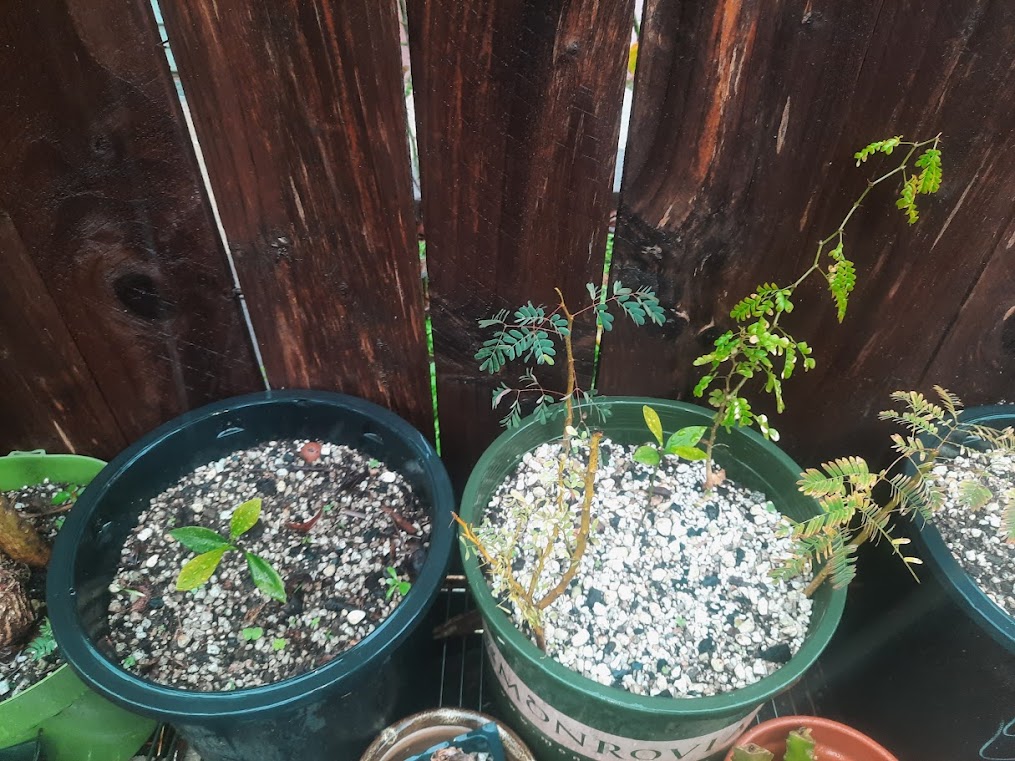
right pot includes senegalia burkei, senegalia galpinii, senegalia mellifera and ebenopsis ebano. i have 3 other pairs of garcinia intermedia pots, but with different legumes.
the next experiment, which i started 21 feb, involved jaboticaba seeds (purchased from bellamy trees)...
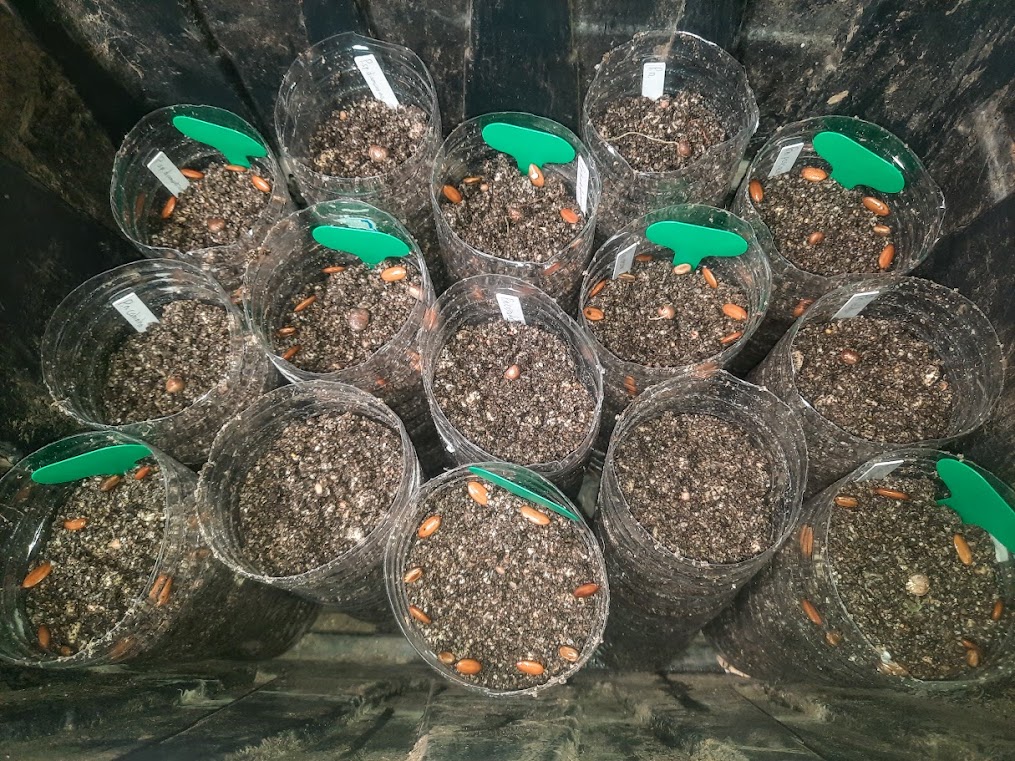
pots with green labels also included seeds of albizia julibrissin. the other pots included granules of osmocote.
pic taken 10 mar...
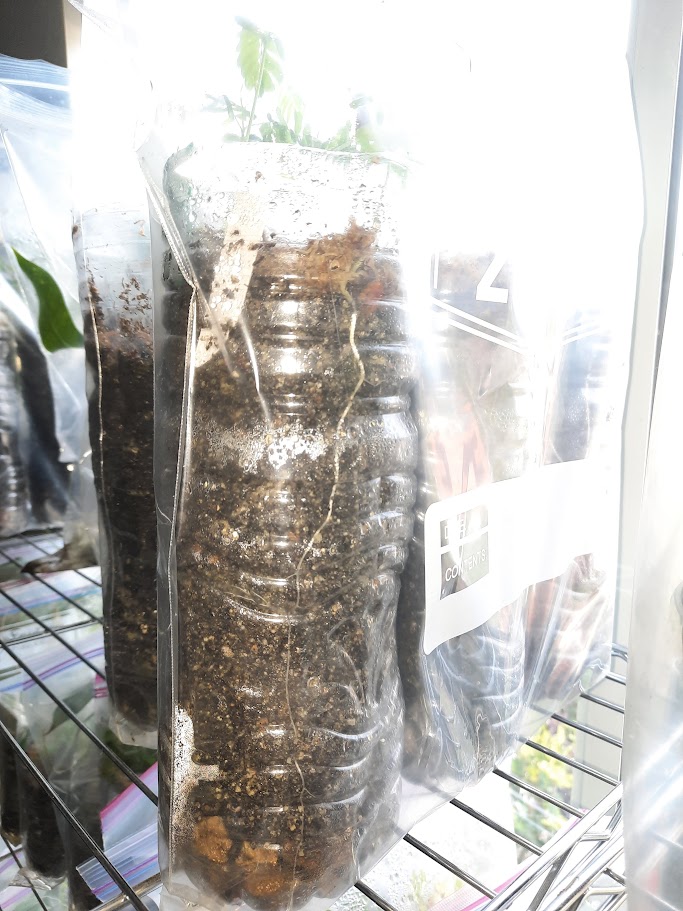
the albizia roots quickly reached the bottom of the pot where i had placed rocks from my front yard. i don't cut the drainage holes on the bottom of the pots, i cut them around 1" from the bottom which creates a water reservoir. my impression is that this is beneficial in my relatively dry conditions.
now i'm really curious which legume would win the race to the bottom. even though that wikipedia entry has nothing to do with testing which legumes can grow their roots down the fastest, it's relevant to the big picture. recently i read this about annona monticola... "This tree has unique adaptations for surviving in the challenging cerrado climate, including an extensive root system that taps into deep groundwater, ensuring its survival and helping nearby plants retain moisture". can anyone find the original source? (source for general concept) it sounds like annona monticola is really magnanimous, freely sharing its water with nearby thirsty neighbors. in reality though, the thirstier its neighbors, the more the monticola charges them for water... aka price gouging. but what if there's another monticola 10' away? in this case, neither has a monopoly on water, and unless they can collude, they will have to compete with each other, which effectively lowers the price of water. with this in mind, this is why i try to surround the fruit tree seedlings with legumes. this provides the fruit tree seedlings with the upper hand, in theory.
pic taken yesterday...

if you look closely at the left pot you can see a jabo seedling with a leaf shaped like a pie slice. the right pot jabo seedling is a lot larger. the jabo seed in the middle pot doesn't seem like it's germinated yet. correlation doesn't mean causation.
the most recent experiment involves seeds of monstera deliciosa thai constellation, which is variegated. on 12 sept 2022 my friend michelle harvested pollen from her variegated monstera borsigiana, which i used to try pollinating the 1st of 2 flowers to open on my deliciosa (15 oct 2022). this january one of the fruits fell off. i couldn't remember if it was the one i pollinated. after a couple days in a paper bag, most of the outer shell easily fell off, which meant it was ready to eat. if you don't wait for the outer shell to fall off on its own then it's like eating fiber glass (oxalate crystals). since i waited, it was like eating a combination of banana and pineapple. very tasty but not a single seed. the 2nd fruit fell off this month...
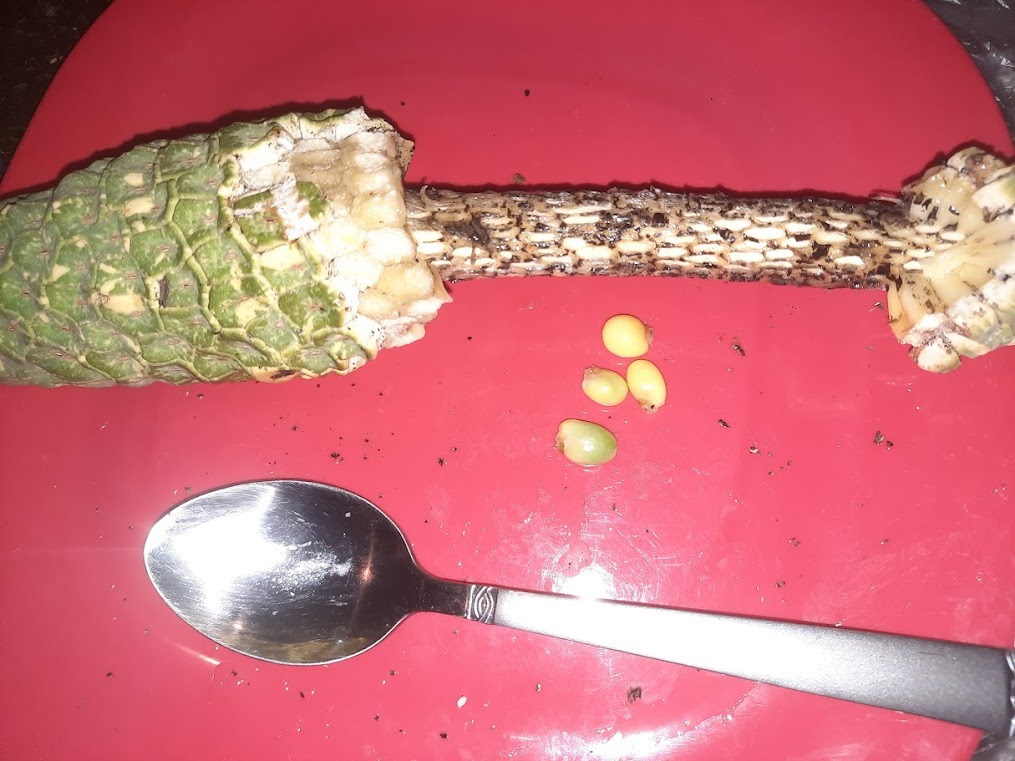
there were a total of 9 seeds, and the fruit was even tastier. the seeds are starting to germinate...
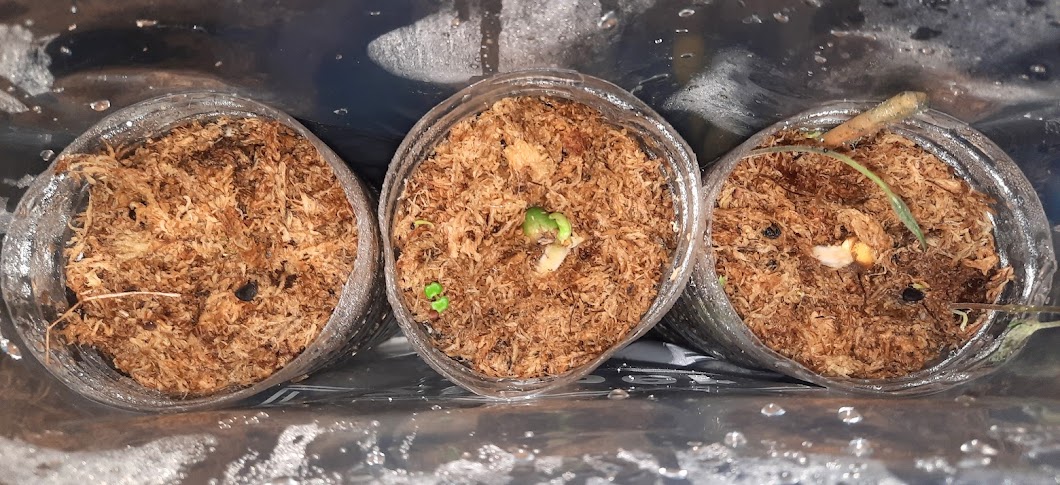
the pot on the right has pigeon pea seedlings and osmocote. other bags have a few pots with only pigeon pea seedlings. none of the pigeon pea seedlings are happy in the bags, they quickly collapse when they touch it. i sowed some pigeon pea in pots outside as well.
naturally i really wish that i had started these experiments a decade ago. why didn't i? i was barking up the wrong trees? standing on the wrong shoulders?
overlooking useful stuff is way too easy. we all do it all the time.
How long until nitrogen fixers fix nitrogen?
What is the point of Nitrogen fixing trees without Inoculant?
both those threads give the impression that the only way that plants will benefit from nearby legumes is via the full or partial death/decay of their roots, shoots, leaves and flowers. unless i overlooked it, which is entirely possible, no one mentioned the idea of legumes simply trading, via fungi, their surplus nitrogen for their neighbors' surplus water, sugars, potassium and so on.
a long time ago, when i was overlooking the usefulness of legumes, in my backyard i unintentionally had leucaena leucocephala (guaje) and bananas growing right next to each other. the guaje just happened to volunteer right next to the banana and i didn't get around to removing it. that thing sure grew fast. so did the bananas. i remember constantly having to remove banana pups. i never put 2 and 2 together. it was only just recently that i suspected the possibility that the guaje was trading its surplus nitrogen for the banana's surplus potassium. florida natural farming (fnf) is on a mission to plant bananas next to all his numerous fruit trees.
what's a gardener? someone who makes it easy for diverse plants to trade with each other?
what's a leader? when i lived in china 20 years ago, it was easy for diverse people to trade with each other, thanks to deng xiaoping. previously, mao zedong made doing so very difficult. the results were predictable?
no 2 groups make it equally easy for their members to trade with each other. plenty of groups make it relatively easy for people to trade plants with each other, for example, but when it comes to ideas about plants, it's a completely different story. all of a sudden the rules of economics are magically irrelevant...supply and demand goes out the window...there's no need to see the demand for plant ideas. the results are predictable? suffering from a shortage of useful plant ideas is worse than suffering from a shortage of useful plants. there wouldn't have been a famine in china if the rest of the world had made it impossible to overlook the usefulness of markets. unfortunately, "the wealth of nations" wasn't on the list of bestsellers.
why spend your money on ideas you can have for free?
deserts around the world are rapidly expanding, and there are lots of ideas about greening them, but there's no market where we can use our money to make it impossible to overlook the most useful ideas. to be clear, useful and popular really aren't the same. popularity is what rises to the top of youtube. useful is what rises to the top of markets. youtube could be, and should be, a market, but it isn't. unsurprisingly neither is google...Costly signaling theory is also pretty useful. I suppose the peacock's tail is the standard view. What seems undoubtedly true is that humans, like peahens, attach significance to a piece of communication in some way proportionally to the cost of generating or transmitting it. Instinctively, you will open the FedEx package on your desk before you open the letter. One of the problems of email is there's no cost attached to sending it, so we don't have a useful heuristic for deciding what to read first. That strikes me as interesting. - Rory Sutherland, Things to Hang on Your Mental Mug Tree
that article didn't used to be behind a paywall, but now it is. putting ideas behind paywalls is certainly one way to get people to spend money on them. but there's a market conundrum or paradox. before you've read an article or book, you have no idea how useful its ideas are to you. afterwards, you do know, but then there's no incentive to pay accordingly. the solution is for all ideas to be freely accessible, but to be ranked by the amount of money that people spend on them. want to free-ride? sure, no problem, but it means that your favorite ideas won't get the attention you think they deserve.What is God? It is only a subject that has inspired some of the finest writing in the history of Western civilization — and yet the first two pages of Google results for the question are comprised almost entirely of Sweet’N Low evangelical proselytizing to the unconverted. (The first link the Google algorithm served me was from the Texas ministry, Life, Hope & Truth.) The Google search for God gets nowhere near Augustine, Maimonides, Spinoza, Luther, Russell, or Dawkins. Billy Graham is the closest that Google can manage to an important theologian or philosopher. For all its power and influence, it seems that Google can’t really be bothered to care about the quality of knowledge it dispenses. It is our primary portal to the world, but has no opinion about what it offers, even when that knowledge it offers is aggressively, offensively vapid. — Franklin Foer, The Death of the Public Square
admittedly, i might be wrong about... everything. i'm sure there's a ton of really useful ideas that i'm overlooking. maybe i'm overlooking a study with credible evidence that markets aren't so useful. so even if i had the ability to somehow mute people who disagreed with me, i wouldn't do it. i got this idea from standing on mill's shoulders...
which are the most useful and relevant ideas that i'm overlooking? and how much are they worth to you?But the peculiar evil of silencing the expression of an opinion is, that it is robbing the human race; posterity as well as the existing generation; those who dissent from the opinion, still more than those who hold it. If the opinion is right, they are deprived of the opportunity of exchanging error for truth: if wrong, they lose, what is almost as great a benefit, the clearer perception and livelier impression of truth, produced by its collision with error. — J.S. Mill, On Liberty
practically speaking, as i might have mentioned a few times, here on agaveville we could use donations (to this forum) in order to help influence the order of the forum categories. not only would this help support the forum, but we'd help elevate the most useful plant groups. we'd see and know the demand for agave ideas and aloe ideas. we'd see and know which demand was greater. this information would make each and every one of us more useful to the group.
at this point i kinda feel like the serpent tempting eve to eat the fruit from the tree of the knowledge of good and evil. in this case i'm tempting you to eat the fruit from the tree of the knowledge of our true plant priorities. you will surely not die. you will definitely not get kicked out of the garden. instead, your garden will make the garden of eden look like an abandoned lot. selah.
